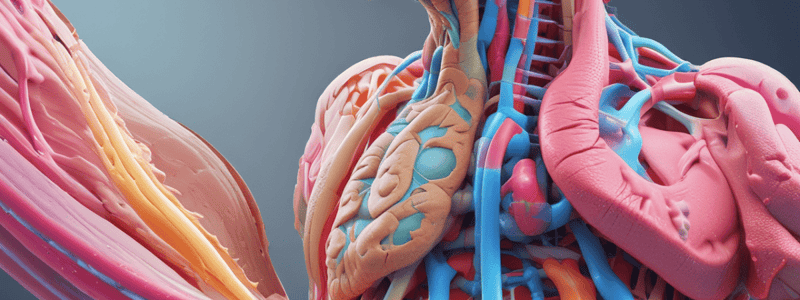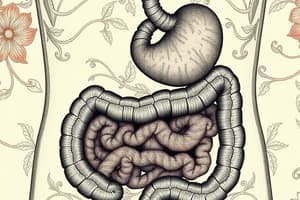Podcast
Questions and Answers
Which cranial nerve nucleus contains alpha-motoneurons that supply the muscles of the palate, pharynx, and larynx?
Which cranial nerve nucleus contains alpha-motoneurons that supply the muscles of the palate, pharynx, and larynx?
- Chewing center
- Nucleus ambiguus (correct)
- Cranial nerve XII nucleus
- Trigeminal mesencephalic nucleus
Which nucleus has alpha-motoneurons that supply the intrinsic and extrinsic muscles of the tongue?
Which nucleus has alpha-motoneurons that supply the intrinsic and extrinsic muscles of the tongue?
- Chewing center
- Cranial nerve XII nucleus (correct)
- Nucleus ambiguus
- Trigeminal mesencephalic nucleus
What is the name of the brainstem center that comprises the central neural pattern generator for chewing?
What is the name of the brainstem center that comprises the central neural pattern generator for chewing?
- Nucleus ambiguus
- Chewing center (correct)
- Cranial nerve XII nucleus
- Trigeminal mesencephalic nucleus
Which component of chewing can be overridden by voluntary control?
Which component of chewing can be overridden by voluntary control?
What is the unique feature of the trigeminal mesencephalic nucleus?
What is the unique feature of the trigeminal mesencephalic nucleus?
How do orofacial muscles compensate for the weakness of reciprocal innervation due to the lack of proprioceptors?
How do orofacial muscles compensate for the weakness of reciprocal innervation due to the lack of proprioceptors?
What type of hormone is GLP-1 classified as?
What type of hormone is GLP-1 classified as?
Which hormone is secreted by D cells of the gastrointestinal mucosa in response to decreased luminal pH?
Which hormone is secreted by D cells of the gastrointestinal mucosa in response to decreased luminal pH?
What is the primary function of histamine secreted by cells in the stomach?
What is the primary function of histamine secreted by cells in the stomach?
Which type of hormone is synthesized in cell bodies of gastrointestinal neurons?
Which type of hormone is synthesized in cell bodies of gastrointestinal neurons?
What effect does somatostatin have on other gastrointestinal hormones?
What effect does somatostatin have on other gastrointestinal hormones?
Which cells secrete GLP-1 in the small intestine?
Which cells secrete GLP-1 in the small intestine?
What neurotransmitter do postganglionic nerve fibers release?
What neurotransmitter do postganglionic nerve fibers release?
Which plexuses can postganglionic nerve fibers synapse on?
Which plexuses can postganglionic nerve fibers synapse on?
What effect does gastrin have on gastric motility?
What effect does gastrin have on gastric motility?
How is gastrin secretion inhibited?
How is gastrin secretion inhibited?
What stimulates the release of cholecystokinin (CCK)?
What stimulates the release of cholecystokinin (CCK)?
How does CCK affect the digestive system?
How does CCK affect the digestive system?
During which phase of the slow waves in the gastrointestinal tract does the balance of inward calcium current and outward potassium current occur?
During which phase of the slow waves in the gastrointestinal tract does the balance of inward calcium current and outward potassium current occur?
What is the frequency of electrical slow waves in the human antrum?
What is the frequency of electrical slow waves in the human antrum?
What initiates changes in sphincter pressure for gastrointestinal tract contents to move through?
What initiates changes in sphincter pressure for gastrointestinal tract contents to move through?
Which type of muscle action potentials appear at the crests of the slow waves in the gastrointestinal tract?
Which type of muscle action potentials appear at the crests of the slow waves in the gastrointestinal tract?
What is the characteristic of muscle contractions associated with each slow wave?
What is the characteristic of muscle contractions associated with each slow wave?
Which phase of the slow waves is characterized by activation of voltage-gated calcium channels?
Which phase of the slow waves is characterized by activation of voltage-gated calcium channels?
What drives colonic contents into the distal part of the large intestine?
What drives colonic contents into the distal part of the large intestine?
How many times per day can mass movements occur?
How many times per day can mass movements occur?
Which reflex triggers mass movements in the colon primarily?
Which reflex triggers mass movements in the colon primarily?
What is responsible for making the fecal contents of the large intestine semisolid?
What is responsible for making the fecal contents of the large intestine semisolid?
What reflex moves remaining small intestine contents into the large intestine?
What reflex moves remaining small intestine contents into the large intestine?
Which reflex triggers the defecation reflex by pushing colonic contents into the rectum?
Which reflex triggers the defecation reflex by pushing colonic contents into the rectum?
Flashcards are hidden until you start studying




